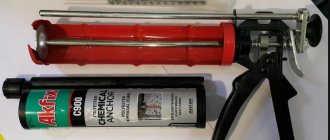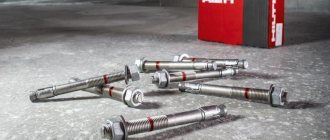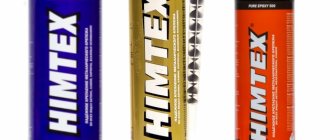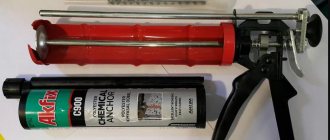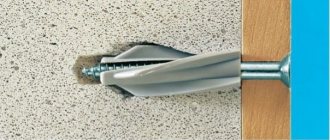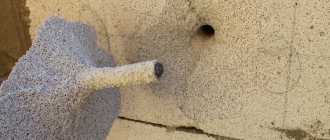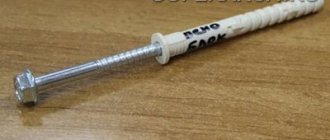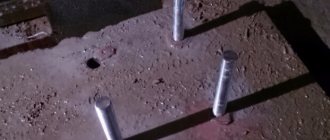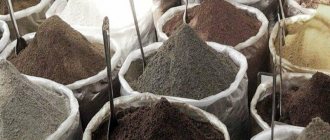Last year, my friend faced a small but unpleasant problem. He decided to hang the TV on the wall. I did the work, praised myself, and went safely on a business trip. I was absent for a couple of months. I arrived home, and his TV died the death of the brave. Why didn't good dowels fulfill their function?
It turned out to be simple: the walls are made of porous raw materials - aerated concrete! And, as you know, it requires the use of a reliable fastening system. I advised him to try using a chemical anchor for foam concrete (although there are other tricks). That same day, of course, he tested it. What can I say? The TV has been on the wall for over a year now, no problems. That is, the fastener can withstand the load perfectly.
I would like to introduce you, dear friends, to this miracle product. Shall we start?
Chemical anchor: product features
So, what is it and what is it eaten with?
Concept
A chemical anchor (adhesive anchor) is a device consisting of a metal rod and a two-component synthetic resin. It penetrates the cells of the raw material with lightning speed, promoting a reliable and strong connection between the fixing product and the base.
Components
Of course, the proportions of the chemical composition of a product are a trade secret of manufacturing organizations. But in general, the product contains:
- artificial resin based on acrylic, polyurethane, polyester;
- quartz sand;
- cement;
- hardener.
In principle, you can create this substance with your own hands, but this is a topic for another discussion.
Anchor types
Chemical anchor for aerated concrete after tearing out
The main reason why standard anchors, for example, dowel-screws, are not suitable is the weak uniform opening of the spacer element. Aerated concrete crumbles quite easily under loads and internal pressure, which is why the fastening of such a dowel can weaken, and the mounted equipment, and even more so furniture, can collapse.
The same applies to dowel nails driven with a pneumatic gun - they do not have an expanding part at all, and are held in place only due to the strength of the material into which they are driven.
Different pore sizes inside the block
As already mentioned, blocks come in different densities. Look at the photo above to see this clearly. The D600 version looks clearly stronger, although it is not the densest block - the strongest brand has a density of 1200 kg/m3. You can also screw standard fasteners into such structures, being sure that they will hold securely.
Advice! From here we will draw the first conclusion - in order to decide on the type of anchor for aerated concrete, first find out its brand. If there is no data, then it is better to play it safe by taking one of the options that we will consider today. Of course their price will be higher, but it's worth it.
Mechanical anchors for cellular concrete
Anchor bolts for aerated concrete Hilti HPD
Mechanical anchors for cellular concrete are often called butterflies, due to the visual similarity of the wedged spacer element to this insect.
They are made of metal, like the one shown above, or have a plastic dowel.
As you can see by looking at the photo selection, the range of mechanical anchors is quite large, and we have not yet shown the whole variety.- Each of the presented models has a certain resistance to vertical and horizontal loads, which must be taken into account when selecting fasteners. You can try to get such information in a store by looking at the specification, but from experience we know that this is almost impossible to do in Russian conditions. Therefore, once you know the mass of the load being hung, look for the necessary data on the Internet.
- All anchors for foam blocks wedge perfectly inside these products. However, many of these designs can damage the load-bearing face of the block when overtightened. For this reason, the manufacturer equips them with a special cuff, border or mark that allows you to limit tightening.
- All models shown can be successfully used for any porous materials.
- To fasten doors and window frames, special models of anchors called frame anchors are used.
Frame anchors for aerated concrete
- If you need to install any lightweight structures, for example, fasteners for air ducts, pipes, and various decorative steel elements, you can use HUS-H type anchor screws.
Hilti HUS3-H6 – self-tapping anchor
Installing these elements is intuitive:
- First, a hole is drilled in the desired location;
- According to the type, a dowel is screwed or hammered into it;
- The screw element (nut, self-tapping screw, bolt) is tightened.
That's the whole procedure. However, it must be remembered that mechanical anchors cannot be used for very heavy loads.
Chemical anchors
For these purposes, chemical anchors are used, which, after installation, become almost one with the block.
Installed chemical anchor in aerated concrete
The operating principle of such an anchor is not much different from a mechanical one, except for a different installation method and the properties of the material used.
pros
The spacer element of such an anchor is an adhesive composition that fills the mounting hole. A metal screw part is installed inside, which can be attached to from the outside. This solution is also suitable for any porous materials.
Here are its advantages and disadvantages:
- The walls of the drilled sleeve do not experience pressure, and even, on the contrary, are strengthened with an adhesive composition. If you remember, in the photo with the torn out anchor there was firmly adhered concrete around the glue.
- The mounting hole is completely sealed.
- Nice cost solution
Minuses
The disadvantages include:
- Quite a long hardening time (up to 48 hours) until the fastener can be used.
- The connection is inseparable - the glue, together with the core, hardens tightly. The only way to carefully remove the protruding part is to cut it off with a grinder and fill the hole with putty.
It is the latter feature that forces one to resort to such a solution only when hanging particularly heavy objects (furniture, TVs, etc.). By the way, pieces of reinforcement can also be immersed in them to create strong bonds with the base.
Chemical anchor installation
Types of filling
The mass with which the mounting holes are filled may have a different chemical composition.
Usually it happens:
- Epoxy;
- Epoxyacrylate;
- Vinylester;
- Polyester.
Similar formulations are sold in tubes or capsules.
Many factors depend on the composition of the mixture, some of which we will now outline:
Vinylester resins are excellent for fixing heavy products operated at subzero temperatures. They feel great when installed in damp conditions, so they are actively used outdoors. They do not contain styrene, the effects of which are considered harmful to the human body.
Epoxy resins are also very popular among builders, because they are able to withstand the largest and heaviest objects, for example: various protective screens, technological equipment for various purposes, etc. Such anchors are mounted on aerated concrete blocks, starting from grade C20.
They consist of two components, which are mixed in a certain proportion, after which they begin to actively harden.
- Epoxy chemical anchors can be installed in high humidity conditions and even under water;
- Like other compounds, they do not create internal stress in a foam concrete structure;
- Suitable for both external and internal use due to the absence of styrene;
- The coupling strength is sufficient even for the use of smooth fasteners.
- It has a very high fire resistance class - R120, which means that when the composition is exposed to an open flame, it will be able to maintain its basic physical properties for 120 minutes.
Important! Polyester compounds are also suitable for indoor and outdoor use. They are harmless to human health and are also among the fastest drying.
The rate of hardening of a chemical anchor depends, first of all, on its chemical composition (can vary from 15 minutes to 48 hours) and environmental conditions (humidity, temperature). The instructions on the packaging will tell you the exact timing of the subsequent installation of the hanging structures.
Installation diagram of a chemical anchor in foam concrete
Scope of application
The chemical anchor holds perfectly in thickness:
- expanded clay concrete;
- aerated concrete;
- foam concrete;
- foam silicate;
- gas silicate;
- foam magnesite;
- gas magnesite;
- foam gypsum;
- gas gypsum.
It is clear that a conventional fastening system on a surface made from this raw material is ineffective. But a chemical anchor is exactly what you need. By using it, you can be sure that it will not fail at the most inopportune moment.
The product is used for fastening:
- monolithic structures;
- brackets;
- reinforcement outlets;
- utilities and engineering networks;
- flights of stairs;
- facing materials;
- fencing on the road (finished) surface;
- household and sanitary equipment;
- industrial units;
- decor items.
The areas of application are countless. But one thing can be said - the technical characteristics of the product open up new opportunities in construction.
Types of fasteners and performance of work
The type of product is selected depending on the expected load:
- for fastening hanging mirrors or lamps, nylon dowels with a cross-section of up to 12 mm are suitable;
- when installing pipelines and bulky objects, choose metal parts;
- frame types of fastenings are used to fix window and door frames;
- universal facade dowels are used when installing external profiles for facing slabs;
- Only light objects are attached to wood screws - photo frames or decorative elements.
Installation is carried out in several stages.
In order for the products to fit tightly into the base, it is necessary to drill the holes correctly. To do this, it is best to use a hammerless drill or a hammer drill with the impact turned off. The drill should have a cross-section 1 mm smaller than the fastener itself. The only exception is steel hardware. For them, the hole will be reduced by 2 mm.
After cleaning the recess from concrete dust, install a dowel. The plastic fastener is screwed in using a screwdriver. Metal parts are driven into the mounting hole with a hammer. During the work, it is necessary to ensure that the product does not warp.
At the final stage, screw in a self-tapping screw or a standard mounting bolt. In this case, it is not advisable to use an electric tool, since when connecting to an aerated concrete block, the screw element may be damaged.
Advantages
The product has a lot of advantages and a small cart, namely:
- durability;
- safety;
- multifunctionality;
- practicality;
- high strength;
- no odor;
- compatibility with any materials;
- ease of use;
- tightness of the hole after installation;
- no tensile stress;
- resistance to the destructive influence of chemical, thermal, mechanical, biological and climatic factors.
There are many obvious advantages, but there are also negative aspects.
Features of adhesive mixtures based on epoxy resin
The compositions are among the most popular means of fixing anchor rods. They are used in the installation of complex technical structures, for securing concrete elements and noise-reducing screens. This substance was specially developed for blocks of class above C20-25.
The features of the material that determined its demand include:
- Ability to operate fastenings in wet environments and under water.
- No toxic substances.
- Acceptability of use during outdoor work.
- Versatility. During installation, you can use smooth and threaded fastening systems.
- This technique does not create tension inside the element.
Kinds
Chemical fasteners are:
- ampoule;
- capsule (injection) in tubes and cartridges.
The ampoule anchor is a miniature glass cylinder. It contains a resin that hardens upon contact with air. It does its job perfectly, but the ampoule is intended for only one hole. Everything would be fine, but! If the hole is relatively large, the resin will not be able to completely fill it. What does it mean? Elementary Watson! There will be very little substance in the hole, and the fastener will not withstand the load.
Capsule anchors in cartridges are represented by small containers with miniature spouts through which glue is squeezed into the hole. And the anchor in the tubes is a substance hidden in a large reservoir. To use it, you need to acquire a construction pistol.
Products are also classified according to the temperature of use. The following types of product are available:
- summer;
- winter;
- spring-summer-autumn.
Summer products are used at temperatures +5 – +40°C. Spring-summer-autumn products are used at temperatures of -10 – +40°C. Winter devices are designed to operate at temperatures of -26 – +20°C.
In view of this, it is necessary to pay attention not only to the appearance, but also to the temperature regime.
DIY making
Considering the fairly high cost of chemical type anchors produced by various manufacturers, in some cases it is advisable to make such fasteners with your own hands. As noted above, the composition of the glue is kept a big secret by manufacturers, so it will not be possible to recreate it on your own.
However, no one bothers to use cheaper glue for these purposes, which can be epoxy resin. Along with their affordable cost, epoxy resins are characterized by fairly high strength and good adhesion to building materials (brick, concrete, foam concrete, etc.), which makes it possible to use them for installing anchor bolts.
It is better to take non-shrinkable epoxy resin
Epoxy resins, which can be purchased at an affordable price at any hardware store, include several components:
- the epoxy resin itself;
- a hardener that ensures its polymerization;
- fillers, which can be cement or gypsum;
- solvent;
- additives that improve various properties of the adhesive mass (plasticizers, etc.).
The consumption of plasticizer, which is necessary for preparing an adhesive composition based on epoxy resin, is 5–10%. The mixture formed from resin and plasticizer is thoroughly mixed. Only after that cement or gypsum is added to it as a filler.
After mixing, a hardener is added to the resulting composition, maintaining a ratio of 1:8 to 1:10. After thoroughly mixing the resulting mass, you can begin to use it.
The advantages of such an adhesive composition, in addition to its affordable cost, include:
- high strength and wear resistance;
- minimum shrinkage coefficient during hardening;
- Possibility of use in a wide temperature range (from –10° to +35°).
Epoxy adhesives also have a number of disadvantages.
- This composition hardens within 1–2 hours, and reaches maximum strength only after 12 hours.
- Epoxy resin based glue can only be used on dry surfaces.
- The composition may release small amounts of phenolic compounds into the atmosphere.
Installation
Fastening anchors is not likely to cause any difficulties. But if in doubt, read the instructions carefully.
The method of installing the ampoule product is very simple. We do the following work:
- determine the consumption of anchors (number of holes = number of anchors);
- drill a hole;
- we clean it of debris;
- place the ampoule in the hole;
- screw in the rod (stud anchor).
And then the following happens: the ampoule breaks, the adhesive composition flows out, filling the hole, and sets, and the fragments perform a reinforcing function.
To install a capsule product, we perform the following steps:
- drill a hole;
- we clean it of any kind of contamination;
- squeeze the adhesive substance into the hole;
- insert the fastener.
- We wait for the substance to harden, filling the unevenness and pores of the raw material.
Chemical anchor is an ideal fastener for aerated concrete, foam concrete and other porous materials.
Mounting methods
There are several main ways to install chemical anchors:
- Glass ampoule. Sold ready-made with threaded rod. The ampoule is inserted into the drilled hole. Then the pin is screwed in.
- Tuba. The chemical anchor is sold in a special plastic container for the glue gun. Inside the tube, the chemical reagents are separated. After squeezing into the hole, they mix.
The use of a chemical anchor for fastening into aerated concrete allows us to solve the main problem - tearing out the anchors. The adhesive composition completely fills the hole, securely clamping the pin.
It can be used to attach suspended structures to walls made of hollow or weakened ceramic bricks.
Similar articles
- Chemical anchor Chemical anchor
.
It is an anchor
bolt of suitable dimensions, has anti-corrosion properties and is resistant to
the chemical
components contained in the adhesive solution, forming strong adhesion with them. Its installation is carried out as follows - in the wall... Read more - Anchor pull-out test methods
Description of
the anchor
bolt.
An anchor
bolt is a durable alloy steel rod 30-200 mm long
... a chemical anchor
. In addition to the frictional force, the rod is held in the hole due to the adhesion of the cementing paste and the base material. The result is a monolithic connection with... Read more - How to decorate a house made of foam blocks from the outside: types of materials
When producing foam blocks, you need to take into account the fact that there will be open pores on their surface. What can happen to a foam block wall: 1)… Read more
- Bracket for ventilated facades: types and functions
A facade bracket is an element for fastening a substructure in a system of ventilated facades; it comes in various shapes: L or U-shaped section. Used to attach the profile to the supporting base - with... Read more
- Technology of installation of ventilated facades: device...
Description of the technology for installing ventilated curtain facades. Construction of subsystem and insulation. Types and installation schemes of ventilation facades depending on the material... Read more
- Do-it-yourself metal profile lathing for siding
The construction industry is developing along the path of simplifying and speeding up work, as well as improving the quality of building materials. Heavy and bulky buildings are being replaced by easily erected... Read more
Price
Of course, the price of a product depends on a lot of factors. But, in general, the product in ampoules can be purchased for 200 - 600 rubles. Fasteners in capsules or tubes can be purchased by paying 1800 - 2400 rubles. Agree, the price is steep, but...
A chemical anchor is a guarantor of reliable connection of all kinds of elements on surfaces made from a variety of raw materials! Solid, safe and durable fastening to you, friends! Bye!
Wisdom Quote: Strong people are always simple (Leo Tolstoy).
Dowel
The part is a spiral-shaped bushing with ribs on the surface. At the moment the screw is screwed in, they expand, due to which they firmly fit into the soft surface of the base. Such fasteners can be made of galvanized steel or plastic.
The first option is the most common and is considered the most expensive. It is used when installing profiles, installing attachments and furniture, and fixing various pipelines. Such fasteners have become widespread in fire-hazardous spaces.
Metal dowels for aerated concrete are produced in 2 modifications, which differ in design features and installation methods. The parts can either be screwed into the base or driven into it. The latter option is used if the aerated concrete floor is planned to be equipped with a collet.
Based on the shape of the fixation ribs, fasteners with a classic helical spiral and dowels in the form of a cone, equipped with spiral blades, are distinguished. The design of metal elements also provides for the presence of a locking flange or cuff, thanks to which the part will not rotate.
The only drawback of such fasteners is that they are susceptible to rust.
Corrosion resistance is the main advantage of plastic products. The materials used for them are polypropylene and polyethylene. The positive characteristics of the parts include their efficiency, environmental friendliness, and immunity to aggressive environments. Such dowels are not intended for outdoor work, since with the onset of cold weather the plastic may burst.
A separate group consists of fasteners for aerated concrete made of nylon. They are more wear-resistant, so they can be used for cladding facades. Together with them, galvanized screw elements with 2 types of heads are used - countersunk or hexagonal. The disadvantage of this type of fastening is the high price.
Depending on the scope of application, there are several types of dowels:
- Universal
. It can be mounted in any concrete surface. In a solid base, fixation occurs in a standard way. In a cellular coating, the product is rolled into a persistent knot. However, the load-bearing capacity of universal dowels is lower than that of spacer elements.
- A dowel-nail that has a wide range of applications. At the moment of fixation, a nail is inserted into the fastener, rather than a screw being screwed in. In order to avoid turning the part, use a sleeve.
- "Pancake-like" structure
frame dowelsallows you to reduce the load on the porous surface of the block.
Anchor for aerated concrete - we consider the types of fastening devices
Cellular concrete is increasingly becoming part of our everyday life, replacing many block materials in low-rise private and mass construction. There are many reasons for this, ranging from reasonable cost to excellent thermal insulation properties.
However, this material has one significant drawback - it is fragile and cannot cope with any serious loads. This applies primarily to low-density blocks, which are used for insulation.
For this trivial reason, many are puzzled by the question of how to install mounted equipment on such walls. Today we will analyze mechanical and chemical anchors for aerated concrete - look at their varieties and basic properties.
Dowels for walls based on foam blocks
Insulating walls with foam plastic from the outside, how to insulate a house with your own hands, technology, video instructions for external installation
Foam blocks are one of the best building materials. Their advantages are so numerous that they more than outweigh the disadvantages. But one of the disadvantages is that the strength of this material is not very high for mounting anything heavy on the walls. However, this was the case before, but now the situation has changed significantly. After all, modern fastening materials have made a big leap in their development.
Dowels - what’s special about them
The dowels are based on a collet, which is divided into four petals. When screwing into the surface of any material, not just foam block, the collet, thanks to its external thread, is perfectly held inside. Well, after screwing it in, it opens up, thereby adhering even more tightly to the material. Thus, the fixation is much more serious, and you can hang anything you like on such dowels.
Another attractive feature of these fastening devices is that they can be reused. If we are talking about metal options, of course.
Metal and plastic dowels
The difference in these fastening materials lies in the material used to make the collet. The metal dowel is made from durable galvanized steel
The material is protected from corrosion, which is important. Metal is used when it is necessary to secure something massive
As for plastic dowels, they are cheaper than their metal counterparts. They are made of nylon, which is resistant to various external influences. At the same time, it does not degrade over time.
Important! For plastic dowels, the wall should be drilled first. Moreover, given the softness of concrete, this can be done even without a hammer drill.
Metal versions do not require pre-drilling. The choice of diameter is extremely important, since the strength of the anchor seat in the wall depends on this parameter. It is best to make holes twice as narrow as the anchors. This way, the shrinking plastic will fit most tightly into the wall. At the same time, you also need to understand that the deeper the hole, the better the quality of fixation that can be obtained in the end.
Frame options
For particularly serious fastening requirements, it is necessary to use frame dowels. Their collet is distinguished by its increased length, which in turn makes it possible to increase the area of interaction of the expanding petals with the material. Moreover, such fasteners can be either metal or plastic. They are usually used when mounting windows and doors, as well as other heavy structures, on porous concrete.
What will we attach to the foam concrete wall?
It is worth noting that it is not always necessary to resort to the use of dowels
Well, then, when you still can’t do without them, it’s important to choose exactly what you need:
- Paintings and other light things. In this case, the dowel will not be needed at all, since it can be secured with an ordinary nail. However, the pictures are different, and you need to focus on the mass. As for hangers, it’s better to play it safe here, since they are often littered with clothes, and heavy winter ones at that;
- Facade structures. We are talking about external work, since foam concrete walls, as a rule, undergo serious finishing. In this case, fastenings can be carried out using specialized facade dowels. There are special SHR models on the market that are ideal for facades, including ventilated ones;
- Relatively small loads. Reasonable sized mirrors or lighting fixtures can be mounted on nylon models;
- Heavy structures. If you are hanging a massive TV or wall-mounted furniture on a foam concrete wall, and also installing fasteners for a pipeline, then it is better to use the most durable and reliable plastic options.
Principle of operation
The operating principle of all dowels for foam concrete is the same. When screwing screws into them, the segments of the collet are folded, thereby increasing the surface along which the dowel is adjacent to the load-bearing support itself or the thread of the dowel itself is securely screwed into the base.
Installation tool for screwing in dowels.
Operating instructions:
- drill a hole in strict accordance with the size specified by the manufacturer for each dowel;
- clean the hole;
- insert the dowel into the hole using a special attachment;
- if it is a screw-in dowel, then twist in the direction specified by the manufacturer;
- We mount the part by tightening the screw to the required depth.
Dowel for foam block - options and use
Dowel for foam block, what is a dowel anyway? Consists of: a galvanized screw, a ring, a half ring, and also a hollow collet, which has a spacer part. Its length must be selected according to thickness; the dowel also has four fixation segments. These bolts have a countersunk head.
No less important is another detail of the dowel - this is the so-called side, it is protection against falling into the hole you drilled. And sharp teeth are needed so that there is an obstacle when turning around its axis
Dowels for foam block
Since the time of construction, when finishing any building, you have to constantly attach something to its walls, for example, household appliances, pieces of furniture, and so on. Every man is familiar with the drilling process.
There are a lot of ways to fix various products on the surface, but to do this you need to use a variety of fasteners. But if the buildings are made of foam blocks, then a number of certain difficulties arise here.
The reason for this is the high porosity of the cellular concrete itself, which does not allow working with any of the fasteners. Therefore, construction experts believe that this is a huge “minus” of it. But, nevertheless, foam block is one of a number of popular materials for budget construction, so many people have to work with it. And yet, what to do?
To make the fastener very reliable on the foam block, it is enough to use a special dowel. Special dowels are made either from metal or plastic, most often from nylon. The material itself can be “driven” in only two ways, namely by screwing or “planting” into a drilled hole.
Fasteners for foam block, its types
The dowel for the foam block has two types: metal or plastic. They are rich in unique cut threads, which provide durable, very high-quality fasteners not only for paintings, but also for plumbing fixtures. There are types that can be installed without drilling walls, and there are those that require preliminary preparation.
Let's look at the metal version - its use involves increased loads on the fastener. It has 4 spacer segments, they are needed to ensure rigid fixation at the installation site. Their teeth provide the strongest adhesion to the wall.
As for plastic dowels, they are considered universal, since they are used everywhere, but if the structure that is attached does not have too much weight and is not subject to excessive mechanical stress.
For everyday use, it is enough to use a dowel with a diameter of 4 to 12 mm. You can screw almost any hardware into it, for example, it could be a screw, screw or self-tapping screw. There is a thread on the surface, it is intended for screwing into foam concrete. Their length ranges from 3 to 6 cm. You can purchase them either individually or in packages.
It is also worth remembering the type of dowel called a “nail”. It is not always used, because it is only suitable for fastening objects on blocks with high density.
Main settings
In rooms that have an increased level of fire safety, only metal dowels should be used. It can also be used for installation of all kinds of building structures. Due to the fact that it is made of nylon, it is widely used in construction work.
A positive characteristic for the dowel is the lightness and durability of the plastic. Most often they are used for fastening small household items to foam concrete walls. Their sizes should be selected according to the load that awaits them.
Fastener selection criteria
There is one very important rule when selecting consumables for foam blocks. It is worth considering all aspects when purchasing dowels:
- for hanging a picture or photo frame, the most ordinary nail is quite suitable;
- metal anchors should be used for heavy office items, as well as furniture;
- if fasteners are needed for the installation of various pipelines, dowels for spacers are required;
- plastic dowels are best suited for securing washing machine hoses, as well as window frames;
- metal fasteners are good for facade work;
- For the most reliable fastening, so-called skirts are used; when twisted, they open the teeth, thereby forever cutting into the block itself, ensuring complete solidity of the wall and the fastener itself.
We can conclude that the dowel for foam blocks is intended for fastening various elements to foam concrete blocks.
What are aerated concrete anchors?
For the construction of low-rise buildings, aerated concrete, or rather foam block, is increasingly being used. The material is light and porous and needs protection from external factors. For finishing houses made of aerated concrete, a hinged ventilated facade is used, the basis of which is load-bearing profiles. Anchors are used to attach the profile to the foam block.
An anchor is a cylindrical fastening element consisting of a spacer part and an internal rod.
The diameter of the fastening element is 8-30 mm. The length depends on the type of base, the weight of the suspension system and the thickness of the wall. Usually 40-300 mm.
